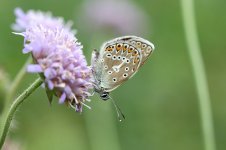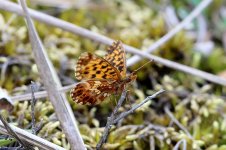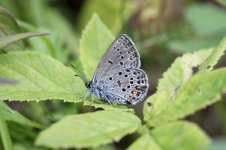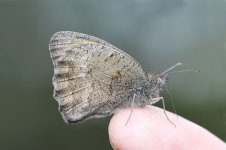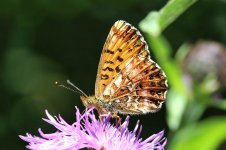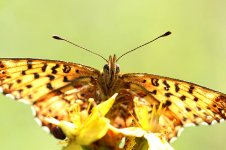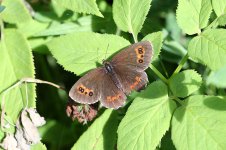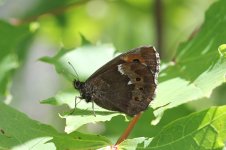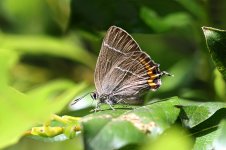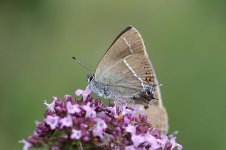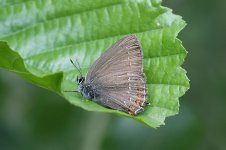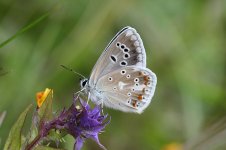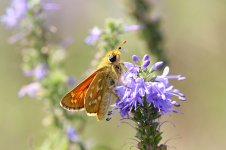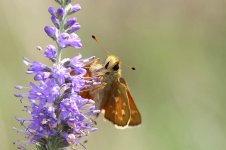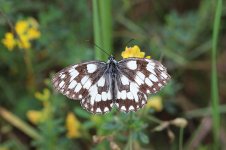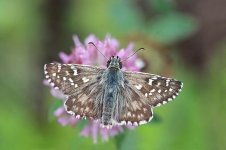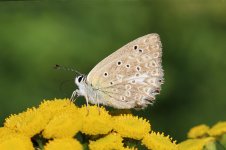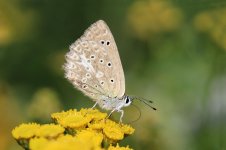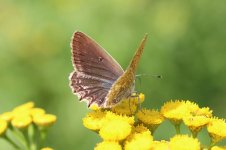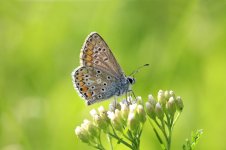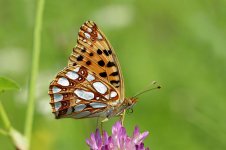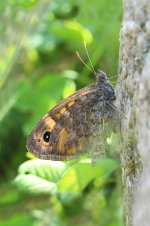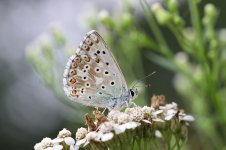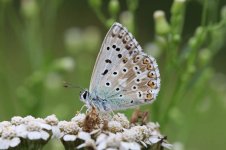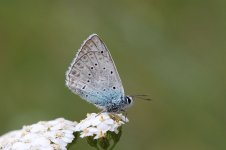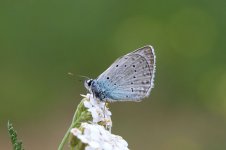
-
Welcome to BirdForum, the internet's largest birding community with thousands of members from all over the world. The forums are dedicated to wild birds, birding, binoculars and equipment and all that goes with it.
Please register for an account to take part in the discussions in the forum, post your pictures in the gallery and more.
You are using an out of date browser. It may not display this or other websites correctly.
You should upgrade or use an alternative browser.
You should upgrade or use an alternative browser.
Baltic Butterfly Challenge, 2016 (1 Viewer)
- Thread starter Jos Stratford
- Start date
More options
Who Replied?
9 July. Latvian Extravaganza.
Two targets for me in Latvia - Titania's Fritillary and Arran Brown, the first of these recorded in Lithuania solely on the basis on a specimen found in an old collection, whilst the second is localized. In Latvia however they are more widespread and at a location south of Cesis, both are apparently common.
And a top class day I had, arriving at 8.00 a.m. at a fantastic area of flower meadows and patches of mixed forest. Early morning cloud was just burning off and already a heady cocktail of butterflies were sitting up on due-drenched flower tops taking in the first rays of the sun. Black-veined Whites, Northern Brown Argus, Geranium Argus, oodles of Silver-washed Fritillaries, Small Pearl-bordered Fritillaries and Lesser Marbled Fritillaries, plus Dark Green Fritillaries and High Brown Fritillaries also in the mix. Hundreds of Essex Skippers too, with lesser numbers of Small Skippers and Large Skippers also present.
Didn't find either of my two main targets initially, the sheer volume of other fritillaries a somewhat hindrance to picking out the less abundant Titania's Fritillary. Also got a little sidetracked by an exquisite White-letter Hairstreak that I found at the edge of the meadow, then after about ten minutes with this butterfly, I noticed a fritillary on a cornflower just adjacent ...my first Titania's Fritillary of the day! Super stuff, the underwing of this butterfly is the stuff of an artist's palette, deep reds and purples running into each other, splodges of black and yellow alongside.
My day list was already running to well over 20 species and I had not even left the first meadow yet. Now truly warm, I turned my attention to the woodland edge, walking along a track with broad sunny fringes and bracken slopes ...and there, along with Ringlets by the dozen, my first Arran Browns of the day, two individuals alternating between taking nectar at flowers and resting on the bracken.
More Arran Browns at the next clearing, more beyond that. And so the day continued, a dizzying array of butterflies at every turn - many thousands of butterflies across the meadows and forest edges, additional species including Pallas's Fritillary, Large Copper, White Admiral and Purple Emperor. Also found three Ilex Hairstreaks, one being devoured by a jumping spider, and no less than five Cranberry Blues. As for the target butterflies, I saw at least 15 Titania's Fritillaries (probably more present, huge numbers of assorted fritillaries drifting everywhere) and a minimum of 45 Arran Browns.
Mid-afternoon, I finally departed, thereafter stopping on forest heathland near Riga. Much lower density of butterflies here, but did manage almost 30 species, including a single Large Blue and a couple of Dusky Meadow Browns. Several Rollers also present here, plus Woodlark and other birds.
So ended an excellent day, a massive 49 species seen, one of my highest ever day totals in the Baltic States - all the more remarkable for the fact I had basically only visited two localities.
BALTIC YEAR LIST
90. Titania's Fritillary
91. Arran Brown
Two targets for me in Latvia - Titania's Fritillary and Arran Brown, the first of these recorded in Lithuania solely on the basis on a specimen found in an old collection, whilst the second is localized. In Latvia however they are more widespread and at a location south of Cesis, both are apparently common.
And a top class day I had, arriving at 8.00 a.m. at a fantastic area of flower meadows and patches of mixed forest. Early morning cloud was just burning off and already a heady cocktail of butterflies were sitting up on due-drenched flower tops taking in the first rays of the sun. Black-veined Whites, Northern Brown Argus, Geranium Argus, oodles of Silver-washed Fritillaries, Small Pearl-bordered Fritillaries and Lesser Marbled Fritillaries, plus Dark Green Fritillaries and High Brown Fritillaries also in the mix. Hundreds of Essex Skippers too, with lesser numbers of Small Skippers and Large Skippers also present.
Didn't find either of my two main targets initially, the sheer volume of other fritillaries a somewhat hindrance to picking out the less abundant Titania's Fritillary. Also got a little sidetracked by an exquisite White-letter Hairstreak that I found at the edge of the meadow, then after about ten minutes with this butterfly, I noticed a fritillary on a cornflower just adjacent ...my first Titania's Fritillary of the day! Super stuff, the underwing of this butterfly is the stuff of an artist's palette, deep reds and purples running into each other, splodges of black and yellow alongside.
My day list was already running to well over 20 species and I had not even left the first meadow yet. Now truly warm, I turned my attention to the woodland edge, walking along a track with broad sunny fringes and bracken slopes ...and there, along with Ringlets by the dozen, my first Arran Browns of the day, two individuals alternating between taking nectar at flowers and resting on the bracken.
More Arran Browns at the next clearing, more beyond that. And so the day continued, a dizzying array of butterflies at every turn - many thousands of butterflies across the meadows and forest edges, additional species including Pallas's Fritillary, Large Copper, White Admiral and Purple Emperor. Also found three Ilex Hairstreaks, one being devoured by a jumping spider, and no less than five Cranberry Blues. As for the target butterflies, I saw at least 15 Titania's Fritillaries (probably more present, huge numbers of assorted fritillaries drifting everywhere) and a minimum of 45 Arran Browns.
Mid-afternoon, I finally departed, thereafter stopping on forest heathland near Riga. Much lower density of butterflies here, but did manage almost 30 species, including a single Large Blue and a couple of Dusky Meadow Browns. Several Rollers also present here, plus Woodlark and other birds.
So ended an excellent day, a massive 49 species seen, one of my highest ever day totals in the Baltic States - all the more remarkable for the fact I had basically only visited two localities.
BALTIC YEAR LIST
90. Titania's Fritillary
91. Arran Brown


Peak butterfly season, but rubbish weather - days of cloud and rain, occasioanal sunny patches ...still edging towards the 100 mark though.
10 July. Dip on Scarce Large Blue!
Stopped off on route back from Latvia at the Nemunas River again near Jurbarkas. Hoped to locate Scarce Large Blue - but failed to do so for the second week in a row! in rather windy conditions, I did see 20 species however, including Pale Clouded Yellow, Swallowtail and an interesting butterfly that I debated for quite a while before settling on a rather well-marked Northern Brown Argus.
Its southern cousin, Brown Argus was the other contender, but I think the orange linules on the upper wing were just not prominent enough.
11 July. Hairstreak High.
Phenomenal, I had gone out in search of a Lesser Purple Emperor and in the process stumbled across the biggest collection of hairstreaks that I have ever seen, discounting Green Hairstreaks of course!
Started with a wander along forest tracks, duly finding a tatty Lesser Purple Emperor and my first Camberwell Beauty since the spring, then transferred to meadows immediately adjacent. Hazy sun and 28 C, loads of butterflies out and about, I thought there might be a chance of a hairstreak or two, so worked the area along the woodland edge. Assorted fritillaries, plenty of skippers, heaths by the bucketload, all nice enough. Then I struck gold, or purple to be exact - a patch of purple flowers coated in hairstreaks!!! My eyes almost fell out, a dozen and more on the flowers! Initially thought they were all White-letter Hairstreaks, an impressive enough sight in itself, but then I noticed there were others amongst them! Slightly larger, lacking the distinctive 'w' on the rear hindwing, but sporting a prominent blue spot, these were indeed good butterflies - my first ever in Lithuania, Bluespot Hairstreaks. First there were two, then three together. Then it got even better, an Ilex Hairstreak joined the party!
Amazing, not only the new species for me in the country, but also the first time I have ever seen multiple species of hairstreak sharing a flower top! And just to top it off, I also found my first Turquoise Blue of the year just adjacent!
BALTIC YEAR LIST
92. Bluespot Hairstreak
93. Turquoise Blue
94. Lesser Purple Emperor
12-15 July. Rain and Thunder.
Days of rain, several thunderstorms extremely heavy. Bad news for the peak of the butterfly season, the intensity of the rain certainly knocking out quite a lot of butterflies. In clearer spells, albeit not blessed by sunshine, I did manage another couple of White-letter Hairstreaks within Vilnius city and spent two hours on the morning of the 14th in open forest south of the capital. Not much actually flying, but tramping around, I did eventually find a reasonable collection of species typical for the locality - a few dozen Silver-studded Blues, one Dusky Meadow Brown, several Graylings and, new for the year, four Rock Graylings.
Then light drizzle set in, my search for Reverdin's Blue postponed for another day.
BALTIC YEAR LIST
95. Rock Grayling
16 July. Third Time Lucky.
My target for this day was Scarce Large Blue, a species restricted in Lithuania to scattered localities in the west of the country. As I had already missed the species twice in recent weeks at Jurbarkas, I had planned to widen my search this day, identifying up to a dozen potential sites from satellite images in the Telsiai region.
So here I was at the first, a very good looking locality adjacent to a small river, a swathe of flower-rich damp meadow sandwiched in an oxbow of the river. The weather however was lousy! I had departed Vilnius under a thick layer of cloud, then driven 230 km under similar, finally arriving at my locality to drizzle! The forecast had been somewhat better, hopefully it would brighten sometime soon. Needless to say, a half hour or so at this site failed to produce anything much at all - the grand tally of butterflies amounting to one Wood White, two Meadow Browns and one Essex Skipper!
Still, things were looking far better to the south and west with cracks in the weather appearing on the horizon and great patches of blue edging in. Another of my potential sites was in that direction, so I gave up on site one and drove the 15 minutes or so to the next.
Definitely warmer and brighter on arrival, even if not actually sunny. Also quite a few butterflies flying - Peacocks and Commas on the field margins, Brimstones here and there, one Short-tailed Blue on a patch of clover. To be honest, the site did not look very good for Scarce Large Blue, not only rather dry, but the whole area had also been cut in recent days. I decided to take a walk anyhow. And good that I did, a mere 100 metres from where I parked, a rather chunky blue butterfly flushed from a patch of rank grass, fluttered over to the road verge, then settled again. Great dirty margins to the dark blue uppers, smallish dark spots to the uniform pale brown underwings ...female Scarce Large Blue! Species number 96 for the year. And then out came the sun, the day was suddenly looking a whole lot better!
After about half an hour at this site, not locating any other Scarce Large Blues, I decided not to bother with my other potential sites for the species, but headed instead to the pine forests a little further south. Now warm and sunny, truly impressive numbers of Silver-washed Fritillaries were on the wing, with single clumps of flowers holding upward of 40 to 50 individuals and many hundreds seen in each kilometre section. Also Map Butterflies and Peacocks in good numbers, plus over 20 other species present too, including more Short-tailed Blues, several Holly Blues and three Speckled Woods. Some kilometres further I reached the meadow I had discovered two weeks earlier with Marbled Fritillaries ...even more present today, 30 or so active in the meadow, several rather tatty, but several fresh too. Also one Lesser Marbled Fritillary here, plus yet more Silver-washed Fritillaries (several brown forms), along with High Brown Fritillaries and Heath Fritillaries. One Large Copper too, joining Scarce Coppers, Small Copper and Purple-shot Copper.
Glutton for punishment, I thought I would give the Jurbarkas site another check on the way home - predictably, no Scarce Large Blue. Did see Northern Brown Argus again however.
BALTIC YEAR LIST
96. Scarce Large Blue
17 July. More Hairstreak Highs.
Returned to a site near Ukmerge to see if Twinspot Fritillaries were still flying - one of the only species that I have seen this year, but failed to photograph. Short answer is nope, they weren't - with the notable exception of Silver-washed Fritillary, numbers of all fritillaries at this locality were generally well down, especially so the immense masses of Lesser Marbled Fritillaries now reduced to just 30 or so.
As for other butterflies however, numbers were very good - in meadows, at woodland edge, in open glade, butterflies everywhere. Particularly impressive was a massive patch of thistle that was absolutely shimmering in butterflies - difficult to say exact, but amongst the dozen or so species present, perhaps 150 Peacocks, 60 Commas, at least 100 Silver-washed Fritillaries and 35 Holly Blues, a nice spectacle indeed. And then, at the one end of the thistles, a cluster of White-letter Hairstreaks, 12 in all, very nice!
A kilometre away, on a steep slope that harboured a Twinspot Fritillary two weeks earlier, more hairstreak magic with yet another two Bluespot Hairstreaks, my second sightings in a week, and my second ever in Lithuania! Also ten White Admirals and a couple of Pale Clouded Yellows.
Meanwhile, over in Labanoras, a good selection of coppers - at least 100 Scarce Coppers, one Small Copper, five Sooty Coppers and two Purple-shot Coppers - along with a nice range of others, including 20 more Holly Blues, a Short-tailed Blue and a Speckled Wood.
On route back, did a little reconnoitering for a species I hope to see a little later in the season, more of that later in the month.
10 July. Dip on Scarce Large Blue!
Stopped off on route back from Latvia at the Nemunas River again near Jurbarkas. Hoped to locate Scarce Large Blue - but failed to do so for the second week in a row! in rather windy conditions, I did see 20 species however, including Pale Clouded Yellow, Swallowtail and an interesting butterfly that I debated for quite a while before settling on a rather well-marked Northern Brown Argus.
Its southern cousin, Brown Argus was the other contender, but I think the orange linules on the upper wing were just not prominent enough.
11 July. Hairstreak High.
Phenomenal, I had gone out in search of a Lesser Purple Emperor and in the process stumbled across the biggest collection of hairstreaks that I have ever seen, discounting Green Hairstreaks of course!
Started with a wander along forest tracks, duly finding a tatty Lesser Purple Emperor and my first Camberwell Beauty since the spring, then transferred to meadows immediately adjacent. Hazy sun and 28 C, loads of butterflies out and about, I thought there might be a chance of a hairstreak or two, so worked the area along the woodland edge. Assorted fritillaries, plenty of skippers, heaths by the bucketload, all nice enough. Then I struck gold, or purple to be exact - a patch of purple flowers coated in hairstreaks!!! My eyes almost fell out, a dozen and more on the flowers! Initially thought they were all White-letter Hairstreaks, an impressive enough sight in itself, but then I noticed there were others amongst them! Slightly larger, lacking the distinctive 'w' on the rear hindwing, but sporting a prominent blue spot, these were indeed good butterflies - my first ever in Lithuania, Bluespot Hairstreaks. First there were two, then three together. Then it got even better, an Ilex Hairstreak joined the party!
Amazing, not only the new species for me in the country, but also the first time I have ever seen multiple species of hairstreak sharing a flower top! And just to top it off, I also found my first Turquoise Blue of the year just adjacent!
BALTIC YEAR LIST
92. Bluespot Hairstreak
93. Turquoise Blue
94. Lesser Purple Emperor
12-15 July. Rain and Thunder.
Days of rain, several thunderstorms extremely heavy. Bad news for the peak of the butterfly season, the intensity of the rain certainly knocking out quite a lot of butterflies. In clearer spells, albeit not blessed by sunshine, I did manage another couple of White-letter Hairstreaks within Vilnius city and spent two hours on the morning of the 14th in open forest south of the capital. Not much actually flying, but tramping around, I did eventually find a reasonable collection of species typical for the locality - a few dozen Silver-studded Blues, one Dusky Meadow Brown, several Graylings and, new for the year, four Rock Graylings.
Then light drizzle set in, my search for Reverdin's Blue postponed for another day.
BALTIC YEAR LIST
95. Rock Grayling
16 July. Third Time Lucky.
My target for this day was Scarce Large Blue, a species restricted in Lithuania to scattered localities in the west of the country. As I had already missed the species twice in recent weeks at Jurbarkas, I had planned to widen my search this day, identifying up to a dozen potential sites from satellite images in the Telsiai region.
So here I was at the first, a very good looking locality adjacent to a small river, a swathe of flower-rich damp meadow sandwiched in an oxbow of the river. The weather however was lousy! I had departed Vilnius under a thick layer of cloud, then driven 230 km under similar, finally arriving at my locality to drizzle! The forecast had been somewhat better, hopefully it would brighten sometime soon. Needless to say, a half hour or so at this site failed to produce anything much at all - the grand tally of butterflies amounting to one Wood White, two Meadow Browns and one Essex Skipper!
Still, things were looking far better to the south and west with cracks in the weather appearing on the horizon and great patches of blue edging in. Another of my potential sites was in that direction, so I gave up on site one and drove the 15 minutes or so to the next.
Definitely warmer and brighter on arrival, even if not actually sunny. Also quite a few butterflies flying - Peacocks and Commas on the field margins, Brimstones here and there, one Short-tailed Blue on a patch of clover. To be honest, the site did not look very good for Scarce Large Blue, not only rather dry, but the whole area had also been cut in recent days. I decided to take a walk anyhow. And good that I did, a mere 100 metres from where I parked, a rather chunky blue butterfly flushed from a patch of rank grass, fluttered over to the road verge, then settled again. Great dirty margins to the dark blue uppers, smallish dark spots to the uniform pale brown underwings ...female Scarce Large Blue! Species number 96 for the year. And then out came the sun, the day was suddenly looking a whole lot better!
After about half an hour at this site, not locating any other Scarce Large Blues, I decided not to bother with my other potential sites for the species, but headed instead to the pine forests a little further south. Now warm and sunny, truly impressive numbers of Silver-washed Fritillaries were on the wing, with single clumps of flowers holding upward of 40 to 50 individuals and many hundreds seen in each kilometre section. Also Map Butterflies and Peacocks in good numbers, plus over 20 other species present too, including more Short-tailed Blues, several Holly Blues and three Speckled Woods. Some kilometres further I reached the meadow I had discovered two weeks earlier with Marbled Fritillaries ...even more present today, 30 or so active in the meadow, several rather tatty, but several fresh too. Also one Lesser Marbled Fritillary here, plus yet more Silver-washed Fritillaries (several brown forms), along with High Brown Fritillaries and Heath Fritillaries. One Large Copper too, joining Scarce Coppers, Small Copper and Purple-shot Copper.
Glutton for punishment, I thought I would give the Jurbarkas site another check on the way home - predictably, no Scarce Large Blue. Did see Northern Brown Argus again however.
BALTIC YEAR LIST
96. Scarce Large Blue
17 July. More Hairstreak Highs.
Returned to a site near Ukmerge to see if Twinspot Fritillaries were still flying - one of the only species that I have seen this year, but failed to photograph. Short answer is nope, they weren't - with the notable exception of Silver-washed Fritillary, numbers of all fritillaries at this locality were generally well down, especially so the immense masses of Lesser Marbled Fritillaries now reduced to just 30 or so.
As for other butterflies however, numbers were very good - in meadows, at woodland edge, in open glade, butterflies everywhere. Particularly impressive was a massive patch of thistle that was absolutely shimmering in butterflies - difficult to say exact, but amongst the dozen or so species present, perhaps 150 Peacocks, 60 Commas, at least 100 Silver-washed Fritillaries and 35 Holly Blues, a nice spectacle indeed. And then, at the one end of the thistles, a cluster of White-letter Hairstreaks, 12 in all, very nice!
A kilometre away, on a steep slope that harboured a Twinspot Fritillary two weeks earlier, more hairstreak magic with yet another two Bluespot Hairstreaks, my second sightings in a week, and my second ever in Lithuania! Also ten White Admirals and a couple of Pale Clouded Yellows.
Meanwhile, over in Labanoras, a good selection of coppers - at least 100 Scarce Coppers, one Small Copper, five Sooty Coppers and two Purple-shot Coppers - along with a nice range of others, including 20 more Holly Blues, a Short-tailed Blue and a Speckled Wood.
On route back, did a little reconnoitering for a species I hope to see a little later in the season, more of that later in the month.
Last edited:



18 July. Edging Closer to the 100!
Year list on 96 at the start of the day, three potential species left in Lithuania with reasonable odds of adding to the list - Reverdin's Blue, Large Grizzled Skipper and Silver-spotted Skipper. Over the last decade, I have seen the first of these in seven years out of ten, while both the latter in only four out of ten. Thus, my list of 'guaranteed' species was now exhausted and even in the event of seeing all three of these, I still need one more to reach the big 100, this almost certainly being something I have never seen in Lithuania before.
So to today, time to target Silver-spotted Skipper:
Locality one, a site where I saw one last year, two hours walking under mostly cloudy skies ...Spotted Fritillary, Dusky Meadow Brown, Grayling, Rock Grayling, no Silver-spotted Skipper.
Locality two, an area of meadow where I have seen them several times. Sunny, many butterflies flying, Pale Clouded Yellow and Queen of Spain Fritillary included. Two seconds out of the car, one Silver-spotted Skipper sitting on a flower top!!! Spent an hour here, saw a total of six Silver-spotted Skippers, the first time I have ever found more than a single individual in any one given day. Several Small Coppers also here, plus other odds and ends. Had a look for Large Grizzled Skipper nearby, no joy this day.
BALTIC YEAR LIST
97. Silver-spotted Skipper
Year list on 96 at the start of the day, three potential species left in Lithuania with reasonable odds of adding to the list - Reverdin's Blue, Large Grizzled Skipper and Silver-spotted Skipper. Over the last decade, I have seen the first of these in seven years out of ten, while both the latter in only four out of ten. Thus, my list of 'guaranteed' species was now exhausted and even in the event of seeing all three of these, I still need one more to reach the big 100, this almost certainly being something I have never seen in Lithuania before.
So to today, time to target Silver-spotted Skipper:
Locality one, a site where I saw one last year, two hours walking under mostly cloudy skies ...Spotted Fritillary, Dusky Meadow Brown, Grayling, Rock Grayling, no Silver-spotted Skipper.
Locality two, an area of meadow where I have seen them several times. Sunny, many butterflies flying, Pale Clouded Yellow and Queen of Spain Fritillary included. Two seconds out of the car, one Silver-spotted Skipper sitting on a flower top!!! Spent an hour here, saw a total of six Silver-spotted Skippers, the first time I have ever found more than a single individual in any one given day. Several Small Coppers also here, plus other odds and ends. Had a look for Large Grizzled Skipper nearby, no joy this day.
BALTIC YEAR LIST
97. Silver-spotted Skipper


24 July. Marbled White, Red Letter Day!
Marbled White is not a species to be expected in Lithuania - according to published literature, the only records date from the 1920s (three specimens in Panevezys) and 2001 (one in Viesville). Edging towards my 100th species for the year, Marbled White was not in my thoughts! Chalkhill Blue however was very much in my thoughts, a rare localised species that occurs in a few localities near the southern borders of the country.
Overcast skies again early morning, but with a forecast perhaps offering better, I set off for my destination, the Belarus border zone near Druskininkai. Still cloudy when I arrived, but considerably brighter and quite warm. Spent a while finding a locality that looked promising, then began my exploration, Belarus a mere hundred metres distant at times.
A limited number of butterflies already flying, Wood Whites, Scarce Coppers, Meadow Browns and the like, but most species were still inactive. Started walking around, lots of Peacocks and a few Red Admirals seen ... then a butterfly fluttered past, distinctive white and brown chequering immediately leaving no doubts, Marbled White! A very mobile Marbled White however - after zigzagging around the meadow for quite some minutes, finally it settled and so I got the crucial photographs. Excellent thought I, congratulating myself on my luck.
And then I found another! Only a hundred metres from the first, I initially thought it had to be the same one, but whilst the first had wing damage, the second was pristine. Much to my surprise, I added a third a little while later! Also continued my search for Chalkhill Blues, which ultimately proved unsuccessful (perhaps still a week or so early in the season), but did find several other blues in the process - Short-tailed Blue, Holly Blue, Common Blue and, new for the year, Reverdin's Blue. Also two Swallowtails and a Pale Clouded Yellow.
Did have plans to check another locality for Chalkhill Blue, but two little incidents disrupted my plans, one was the border police catching me in the border zone without passport and thus politely evicting me, while the second was entirely better - a chance happening upon a meadow, a meadow full of yet more Marbled Whites! I truly could not believe it, amongst numerous Scarce Coppers, Map Butterflies, Commas and mixed fritillaries, there were Marbled Whites everywhere, rarely settling, but visiting flower tops, pursuing each other and several appearing to be egg laying. Difficult to count, but I would say there were at least 35 present at this second locality, the site about 4 km from the first. Truly a good day!
Unable to visit my second planned destination, I then decided to drive to a site near Marcinkonys for another attempt on Safflower Skipper, probably too late in the season now, but a good locality anyhow. Didn't find the desired one, but amongst the rich selection I did see were at least 30 Dusky Meadow Browns, two Queen of Spain Fritillaries, a couple of Nickerl's Fritillaries, two slightly tatty Large Blue and one equally tatty Large Copper. Over 30 km north-east of the earlier sites, I also found one more Marbled White!!!
Clearly some sort of influx had occurred, a total of four Marbled Whites had been recorded in the entire country in the previous century, I had seen probably over 40 in the single day!!!
BALTIC YEAR LIST
98. Marbled White
99. Reverdin's Blue
Marbled White is not a species to be expected in Lithuania - according to published literature, the only records date from the 1920s (three specimens in Panevezys) and 2001 (one in Viesville). Edging towards my 100th species for the year, Marbled White was not in my thoughts! Chalkhill Blue however was very much in my thoughts, a rare localised species that occurs in a few localities near the southern borders of the country.
Overcast skies again early morning, but with a forecast perhaps offering better, I set off for my destination, the Belarus border zone near Druskininkai. Still cloudy when I arrived, but considerably brighter and quite warm. Spent a while finding a locality that looked promising, then began my exploration, Belarus a mere hundred metres distant at times.
A limited number of butterflies already flying, Wood Whites, Scarce Coppers, Meadow Browns and the like, but most species were still inactive. Started walking around, lots of Peacocks and a few Red Admirals seen ... then a butterfly fluttered past, distinctive white and brown chequering immediately leaving no doubts, Marbled White! A very mobile Marbled White however - after zigzagging around the meadow for quite some minutes, finally it settled and so I got the crucial photographs. Excellent thought I, congratulating myself on my luck.
And then I found another! Only a hundred metres from the first, I initially thought it had to be the same one, but whilst the first had wing damage, the second was pristine. Much to my surprise, I added a third a little while later! Also continued my search for Chalkhill Blues, which ultimately proved unsuccessful (perhaps still a week or so early in the season), but did find several other blues in the process - Short-tailed Blue, Holly Blue, Common Blue and, new for the year, Reverdin's Blue. Also two Swallowtails and a Pale Clouded Yellow.
Did have plans to check another locality for Chalkhill Blue, but two little incidents disrupted my plans, one was the border police catching me in the border zone without passport and thus politely evicting me, while the second was entirely better - a chance happening upon a meadow, a meadow full of yet more Marbled Whites! I truly could not believe it, amongst numerous Scarce Coppers, Map Butterflies, Commas and mixed fritillaries, there were Marbled Whites everywhere, rarely settling, but visiting flower tops, pursuing each other and several appearing to be egg laying. Difficult to count, but I would say there were at least 35 present at this second locality, the site about 4 km from the first. Truly a good day!
Unable to visit my second planned destination, I then decided to drive to a site near Marcinkonys for another attempt on Safflower Skipper, probably too late in the season now, but a good locality anyhow. Didn't find the desired one, but amongst the rich selection I did see were at least 30 Dusky Meadow Browns, two Queen of Spain Fritillaries, a couple of Nickerl's Fritillaries, two slightly tatty Large Blue and one equally tatty Large Copper. Over 30 km north-east of the earlier sites, I also found one more Marbled White!!!
Clearly some sort of influx had occurred, a total of four Marbled Whites had been recorded in the entire country in the previous century, I had seen probably over 40 in the single day!!!
BALTIC YEAR LIST
98. Marbled White
99. Reverdin's Blue


Species number 100, Large Grizzled Skipper, 24 July 2016
Way back in the spring, the thought of getting 100 species in the Baltic States in the single year was a mere fanciful idea, I didn't actually expect to achieve it. But here I was, on the 24th July, sitting on species number 99, searching for number 100.
A pretty good day weather wise, albeit again with high cloud. Pretty good for butterflies too, with almost 40 species seen, Pallas's Fritillary, Eastern Bath White and Silver-spotted Skipper amongst them. I however was conducting a dedicated search for Large Grizzled Skippers . In several hours of searching, I didn't find it along a track that I have seen them in past years, so tried instead an area of poor soils where pines are naturally reclaiming a hillside. And there, after a half hour's walk, bingo! One Large Grizzled Skipper resting on leaves and flower tops, species number 100!
So a little bit of back slapping, I achieved my target!
What next? Onward and upward ...my target had been 100 species in the Baltic States, but at a country level, the end result could be broken down to 95 species in Lithuania and 52 species in Latvia.
So a new natural target, try to reach 100 in Lithuania alone, and as high as possible for the combined Baltic list. Already I have a couple of potential species in my sights in Lithuania, neither of which I have ever seen in the Baltic States before. Let's see...
Way back in the spring, the thought of getting 100 species in the Baltic States in the single year was a mere fanciful idea, I didn't actually expect to achieve it. But here I was, on the 24th July, sitting on species number 99, searching for number 100.
A pretty good day weather wise, albeit again with high cloud. Pretty good for butterflies too, with almost 40 species seen, Pallas's Fritillary, Eastern Bath White and Silver-spotted Skipper amongst them. I however was conducting a dedicated search for Large Grizzled Skippers . In several hours of searching, I didn't find it along a track that I have seen them in past years, so tried instead an area of poor soils where pines are naturally reclaiming a hillside. And there, after a half hour's walk, bingo! One Large Grizzled Skipper resting on leaves and flower tops, species number 100!
So a little bit of back slapping, I achieved my target!
What next? Onward and upward ...my target had been 100 species in the Baltic States, but at a country level, the end result could be broken down to 95 species in Lithuania and 52 species in Latvia.
So a new natural target, try to reach 100 in Lithuania alone, and as high as possible for the combined Baltic list. Already I have a couple of potential species in my sights in Lithuania, neither of which I have ever seen in the Baltic States before. Let's see...
Last edited:


28 July. Onward and Upward, Luck and Target.
What next? Onward and upward ...my target had been 100 species in the Baltic States, but at a country level, the end result could be broken down to 95 species in Lithuania and 52 species in Latvia. So a new natural target evolved, try to reach 100 in Lithuania alone, and as high as possible for the combined Baltic list. Already I had a couple of potential species in my sights in Lithuania, both of which would be new species for me in the Baltic States.
The 25th to 27th saw continued mixed weather, with the best of the sun occurring whilst I was working, so no real attempts to find anything new, but occasional butterflies did include 17 more White-letter Hairstreaks in the Vilnius area and Swallowtail and Turquoise Blue near my home. Come the 28th however, with a few hours at my disposal, off I thought I would slink for attempts on two possible targets - Brown Argus and Purple Hairstreak, the first of which I have never seen in Lithuania, the second of which I have never seen anywhere! A fine area of grassy meadow in the Neris Valley was destination for the first, steep flower rich slopes seeming as good as anywhere.
Temperatures approaching 30 C on arrival, but the sun very weak and soon snuffed out by light rain! Sat in the car and waited, an hour ticking by, then the clouds thinned and out popped the sun again - time for butterflies! Wandered the slopes, one Swallowtail, two Pale Clouded Yellows, a bunch of Common Blues, my first Little Blue in almost six weeks ...no Brown Argus. Maybe too early in the season, maybe not a good location. Decided to cut back to the car via the outskirts of a village ...a good move, for there sunning on piles of old roofing sheets, one Wall Brown! My first in Lithuania since 2010 and species 101 for the Baltic year, number 96 for Lithuania. What luck!
For Purple Hairstreak, it was a case of eyes to the sky, this is a species that rarely descends to ground level, but prefers instead the canopy of oaks. With the peak flying season late July through to August, it was now time to begin my search. I relocated to an area of oak woodland and strolled along a broad track scanning both trackside flowers and the canopy. One Speckled Wood was the main reward. A kilometre or so along I got to a point where I had seen a brief hairstreak a week earlier, but failed to nail the identification before it disappeared. A very nice spot with high oaks surrounding a small clearing and mid-size oaks encroaching across the open area, all in all a lot of habitat for the oak-loving Purple Hairstreak. A few Peacocks about, plus Wood Whites, then I spotted a midget of a butterfly flying amongst the lower branches of one of the young oaks just in front of me. It landed, I checked with binoculars ...and there the distinctive form of a Purple Hairstreak, a pale underwing with the typical jagged hairstreak line, a single spot at the rear adjacent to the tail. It was probably low enough to even get a photo, but barely had I begun to wade through the grass and it took off, only to land much higher up. Ten minutes later, a second fluttered around the canopy of an adjacent oak, much higher this time and settling only out of sight. So there we had it, my first ever Purple Hairstreaks and species number 102 for the Baltics year list.
BALTIC YEAR LIST
101. Wall Brown (96 in Lithuania)
102. Purple Hairstreak (97 in Lithuania)
What next? Onward and upward ...my target had been 100 species in the Baltic States, but at a country level, the end result could be broken down to 95 species in Lithuania and 52 species in Latvia. So a new natural target evolved, try to reach 100 in Lithuania alone, and as high as possible for the combined Baltic list. Already I had a couple of potential species in my sights in Lithuania, both of which would be new species for me in the Baltic States.
The 25th to 27th saw continued mixed weather, with the best of the sun occurring whilst I was working, so no real attempts to find anything new, but occasional butterflies did include 17 more White-letter Hairstreaks in the Vilnius area and Swallowtail and Turquoise Blue near my home. Come the 28th however, with a few hours at my disposal, off I thought I would slink for attempts on two possible targets - Brown Argus and Purple Hairstreak, the first of which I have never seen in Lithuania, the second of which I have never seen anywhere! A fine area of grassy meadow in the Neris Valley was destination for the first, steep flower rich slopes seeming as good as anywhere.
Temperatures approaching 30 C on arrival, but the sun very weak and soon snuffed out by light rain! Sat in the car and waited, an hour ticking by, then the clouds thinned and out popped the sun again - time for butterflies! Wandered the slopes, one Swallowtail, two Pale Clouded Yellows, a bunch of Common Blues, my first Little Blue in almost six weeks ...no Brown Argus. Maybe too early in the season, maybe not a good location. Decided to cut back to the car via the outskirts of a village ...a good move, for there sunning on piles of old roofing sheets, one Wall Brown! My first in Lithuania since 2010 and species 101 for the Baltic year, number 96 for Lithuania. What luck!
For Purple Hairstreak, it was a case of eyes to the sky, this is a species that rarely descends to ground level, but prefers instead the canopy of oaks. With the peak flying season late July through to August, it was now time to begin my search. I relocated to an area of oak woodland and strolled along a broad track scanning both trackside flowers and the canopy. One Speckled Wood was the main reward. A kilometre or so along I got to a point where I had seen a brief hairstreak a week earlier, but failed to nail the identification before it disappeared. A very nice spot with high oaks surrounding a small clearing and mid-size oaks encroaching across the open area, all in all a lot of habitat for the oak-loving Purple Hairstreak. A few Peacocks about, plus Wood Whites, then I spotted a midget of a butterfly flying amongst the lower branches of one of the young oaks just in front of me. It landed, I checked with binoculars ...and there the distinctive form of a Purple Hairstreak, a pale underwing with the typical jagged hairstreak line, a single spot at the rear adjacent to the tail. It was probably low enough to even get a photo, but barely had I begun to wade through the grass and it took off, only to land much higher up. Ten minutes later, a second fluttered around the canopy of an adjacent oak, much higher this time and settling only out of sight. So there we had it, my first ever Purple Hairstreaks and species number 102 for the Baltics year list.
BALTIC YEAR LIST
101. Wall Brown (96 in Lithuania)
102. Purple Hairstreak (97 in Lithuania)

New Species for Lithuania and the Baltic States!!!
30 July 2016
I was back on the southern borderlands of Lithuania, seeking Chalkhill Blues again. Still Marbled Whites in the area, several in the same areas as the week before, plus a new population of at least 17 at another locality. Pretty impressive influx, only four individuals ever in Lithuania prior to 2016, and I had now seen at least 58 in the space of seven days!
As in the previous week, Chalkhill Blue hunting wasn't successful, I think still too early in the season, but I was not complaining, not only were the Marbled Whites floating about, but also a whole bunch of other highly localized or scarce species, six Silver-spotted Skippers, four Eastern Bath Whites, three Camberwell Beauties, a Bluespot Hairstreak and two Reverdin's Blues amongst them, along with Swallowtails, Pale Clouded Yellows and two dozen other species.
One of this prepared me for one of the last butterflies of the day however - I was just wondering why the sirens of a border patrol vehicle were wailing when I spotted a moderate-sized blue species fly past, distinctively pale on the underside. Initially thought it might be the Chalkhill Blue I was seeking, but when it landed, I was absolutely gobsmacked! Highly distinctive scalloped rear edge to the wings, surely this was not what I thought it was! I followed it round for a while, eventually getting a few nice photographs, my mind simultaneously trying to find alternative identifications to what was in reality clear. But here was nothing else it could be - the butterfly was a female Meleager's Blue, a species I had previously seen in southern France, but one I was pretty sure had never been recorded in Lithuania before!
Back at the car, two friendly border guards were waiting for me, but shucks, even if they hadn't been friendly, I wouldn't have cared ...I had just discovered a new species for the country.
Subsequent checking confirmed that this butterfly had indeed never been recorded in Lithuania or elsewhere in the Baltic States. With a distribution range stretching from southern Europe through to Ukraine, the nearest known populations are in southern Poland, approximately 380 km to the south. Species number 103 for my Baltic year, number 98 for the Lithuanian year and what a cracker!
BALTIC YEAR LIST
103. Meleager's Blue (98 in Lithuania)
30 July 2016
I was back on the southern borderlands of Lithuania, seeking Chalkhill Blues again. Still Marbled Whites in the area, several in the same areas as the week before, plus a new population of at least 17 at another locality. Pretty impressive influx, only four individuals ever in Lithuania prior to 2016, and I had now seen at least 58 in the space of seven days!
As in the previous week, Chalkhill Blue hunting wasn't successful, I think still too early in the season, but I was not complaining, not only were the Marbled Whites floating about, but also a whole bunch of other highly localized or scarce species, six Silver-spotted Skippers, four Eastern Bath Whites, three Camberwell Beauties, a Bluespot Hairstreak and two Reverdin's Blues amongst them, along with Swallowtails, Pale Clouded Yellows and two dozen other species.
One of this prepared me for one of the last butterflies of the day however - I was just wondering why the sirens of a border patrol vehicle were wailing when I spotted a moderate-sized blue species fly past, distinctively pale on the underside. Initially thought it might be the Chalkhill Blue I was seeking, but when it landed, I was absolutely gobsmacked! Highly distinctive scalloped rear edge to the wings, surely this was not what I thought it was! I followed it round for a while, eventually getting a few nice photographs, my mind simultaneously trying to find alternative identifications to what was in reality clear. But here was nothing else it could be - the butterfly was a female Meleager's Blue, a species I had previously seen in southern France, but one I was pretty sure had never been recorded in Lithuania before!
Back at the car, two friendly border guards were waiting for me, but shucks, even if they hadn't been friendly, I wouldn't have cared ...I had just discovered a new species for the country.
Subsequent checking confirmed that this butterfly had indeed never been recorded in Lithuania or elsewhere in the Baltic States. With a distribution range stretching from southern Europe through to Ukraine, the nearest known populations are in southern Poland, approximately 380 km to the south. Species number 103 for my Baltic year, number 98 for the Lithuanian year and what a cracker!
BALTIC YEAR LIST
103. Meleager's Blue (98 in Lithuania)


After a phenomenal few months, August more or less marks the end of the season, many species already in decline by the month's beginning, most others following soon after. Not all bad news however, amongst potential influxes of migrant butterflies and flights of second generations in quite a few species, there also remain a few late season specialities to search for, primarily amongst these Brown Hairstreak and three highly localized species, namely Brown Argus, Chalkhill Blue and, rarest of the lot, Tree Grayling.
1 August. Military Day.
Target one, Tree Grayling. In the Baltic States, this species is restricted to a single locality consisting of a few fragments of habitat in a plot of land barely three kilometres by three kilometres. All of which is within a military training area surrounded by numerous 'no entry' signs and subject to live fire exercises a dozen days or so a month! Hmm, my heart rather sank when I discovered this, open sandy slopes visible beyond the signs beckoning me in, but a military camp atop the slope certainly warding me off! I made a phone call to a Captain in the Lithuanian army to ask if it was actually possible to get in somehow if there was no active training that day. 'Sort of' was the reply, theoretically entry was not prohibited if no training was occurring in that particular zone that day, but it could be closed anyhow for any reason and I would be expected to have a reason to be there if challenged.
That was good enough for me, Tree Grayling seemed a perfectly good reason I thought. Military training was scheduled for some parts of the zone that day and I had already been turned back trying to venture up a forest track a couple of kilometres form my current position, but all seemed quiet where I was. I openly admit being a tad nervous venturing past the line of 'no entry' signs - hopefully I would not get apprehended, or least hopefully I would see the Tree Grayling before the military saw me! I initially searched an excellent area right on the fringes of the zone, i.e. as far from the very visible military camp as I could. And it was super, dozens of Silver-studded Blues all over the place, six Silver-spotted Skippers, three Camberwell Beauties, one Niobe Fritillary and, moving towards the correct family, a dozen Graylings and seven Rock Graylings. No sign of Tree Grayling though! Zigzagged a number of times, Dusky Meadow Browns here and there, but search as hard as I could, not a single Tree Grayling did I find.
From satellite images, I knew more open habitat lay beyond the military buildings, so I decided to try and skirt through the forest and re-enter the heathland a kilometre or so further. Half way up, I thought I was done for, a deep rumbling signified a heavy vehicle coming up a forest track, a military truck of some sort I glimpsed through the trees. Didn't see more than that because I quickly nipped out of sight, then ran pretty nifty a few hundred meters and vanished into an area hidden by bushes. I think they didn't see me, or if they did, perhaps they just didn't care. Out on the open area, I then came across a big barbed wire fence and decided it absolutely prudent not to cross that. Ambled off the other way, Swallowtail floating past, but I still did not find the desired Tree Grayling.
Decided I had pushed my luck enough for the day, perhaps I was still too early in the season for Tree Grayling, I would return another day!
4-5 August. Grasslands.
Target two, Brown Argus. Already two weeks, I had been looking for this, traveling to numerous sites across southern and eastern Lithuania all to no avail. Tried the Ukmerge area on the 4th, cloudy skies basically thwarting my attempts, but the weather on the 5th was simply amazing, blazing sun all day and temperatures touching 30 C. Three localities on my radar this day, one to the west of Vilnius, two to the north. Loads of Common Blues at the first, eight Turquoise Blues and four Little Blues too, but perhaps predictably no Brown Argus. At the next two sites, things were even better - located not too far from each other, they were both buzzing with butterflies, some of the combined tallies including at least 80 Common Blues, an impressive 75 plus Pale Clouded Yellows, 55 Brimstones and 60 Small Heaths. Also one Swallowtail, 13 Little Blues, eight Queen of Spain Fritillaries and 14 Wall Browns.
Walked a couple of hours, wading through Common Blues in search of a Brown Argus all the way. Didn't find one. Almost back at the car, one last 'female Common Blue' fluttering on the slope ...ah ha, but it wasn't one! At last, I had found my elusive target butterfly, slightly faded, one Brown Argus ...one more for the year lists, species number 99 for Lithuania, 104 for the Baltic States.
BALTIC YEAR LIST
104. Brown Argus (99 in Lithuania)
1 August. Military Day.
Target one, Tree Grayling. In the Baltic States, this species is restricted to a single locality consisting of a few fragments of habitat in a plot of land barely three kilometres by three kilometres. All of which is within a military training area surrounded by numerous 'no entry' signs and subject to live fire exercises a dozen days or so a month! Hmm, my heart rather sank when I discovered this, open sandy slopes visible beyond the signs beckoning me in, but a military camp atop the slope certainly warding me off! I made a phone call to a Captain in the Lithuanian army to ask if it was actually possible to get in somehow if there was no active training that day. 'Sort of' was the reply, theoretically entry was not prohibited if no training was occurring in that particular zone that day, but it could be closed anyhow for any reason and I would be expected to have a reason to be there if challenged.
That was good enough for me, Tree Grayling seemed a perfectly good reason I thought. Military training was scheduled for some parts of the zone that day and I had already been turned back trying to venture up a forest track a couple of kilometres form my current position, but all seemed quiet where I was. I openly admit being a tad nervous venturing past the line of 'no entry' signs - hopefully I would not get apprehended, or least hopefully I would see the Tree Grayling before the military saw me! I initially searched an excellent area right on the fringes of the zone, i.e. as far from the very visible military camp as I could. And it was super, dozens of Silver-studded Blues all over the place, six Silver-spotted Skippers, three Camberwell Beauties, one Niobe Fritillary and, moving towards the correct family, a dozen Graylings and seven Rock Graylings. No sign of Tree Grayling though! Zigzagged a number of times, Dusky Meadow Browns here and there, but search as hard as I could, not a single Tree Grayling did I find.
From satellite images, I knew more open habitat lay beyond the military buildings, so I decided to try and skirt through the forest and re-enter the heathland a kilometre or so further. Half way up, I thought I was done for, a deep rumbling signified a heavy vehicle coming up a forest track, a military truck of some sort I glimpsed through the trees. Didn't see more than that because I quickly nipped out of sight, then ran pretty nifty a few hundred meters and vanished into an area hidden by bushes. I think they didn't see me, or if they did, perhaps they just didn't care. Out on the open area, I then came across a big barbed wire fence and decided it absolutely prudent not to cross that. Ambled off the other way, Swallowtail floating past, but I still did not find the desired Tree Grayling.
Decided I had pushed my luck enough for the day, perhaps I was still too early in the season for Tree Grayling, I would return another day!
4-5 August. Grasslands.
Target two, Brown Argus. Already two weeks, I had been looking for this, traveling to numerous sites across southern and eastern Lithuania all to no avail. Tried the Ukmerge area on the 4th, cloudy skies basically thwarting my attempts, but the weather on the 5th was simply amazing, blazing sun all day and temperatures touching 30 C. Three localities on my radar this day, one to the west of Vilnius, two to the north. Loads of Common Blues at the first, eight Turquoise Blues and four Little Blues too, but perhaps predictably no Brown Argus. At the next two sites, things were even better - located not too far from each other, they were both buzzing with butterflies, some of the combined tallies including at least 80 Common Blues, an impressive 75 plus Pale Clouded Yellows, 55 Brimstones and 60 Small Heaths. Also one Swallowtail, 13 Little Blues, eight Queen of Spain Fritillaries and 14 Wall Browns.
Walked a couple of hours, wading through Common Blues in search of a Brown Argus all the way. Didn't find one. Almost back at the car, one last 'female Common Blue' fluttering on the slope ...ah ha, but it wasn't one! At last, I had found my elusive target butterfly, slightly faded, one Brown Argus ...one more for the year lists, species number 99 for Lithuania, 104 for the Baltic States.
BALTIC YEAR LIST
104. Brown Argus (99 in Lithuania)
Last edited:


6 August. Success on the Belarus Border!
Ominous looking skies nearly turned me back, blanket cloud clover and spells of rain on route. I persevered however, my destination once again the Belarussian borderlands to the far south-east of Lithuania. My goal was yet again Chalkhill Blue, plus I planned a perhaps optimistic search for the super star of the week previous, the female Meleager's Blue.
No sun on arrival, but the clouds had thinned to a considerable degree, it was quite bright and certainly warm. Some activity amongst butterflies. I checked a couple of excellent meadows, including the site where I had found the Meleager's Blue, to rather better results than I had feared - along with a dozen or so more common species, one Queen of Spain Fritillary, three Large Grizzled Skippers and several Silver-spotted Skippers. Not bad for starters, no Chalkhill Blue however and, despite quite extensive search, no sign of the Meleager's Blue.
Moving a kilometre further, I then began a search along the wide margins of a sandy track, rough pasture to the one side. Bingo! Almost immediately ran into a male Chalkhill Blue, the uppers appearing an almost ghostly pale whitish-blue when in flight. 100th species in Lithuanian in 2016! Quite a few Common Blues at the same locality. Quite active initially, the Chalkhill Blue briefly had a run-in with another largish blue butterfly at one point, my thoughts running along the lines of 'hmm, that looked interesting' but as it did not settle, I did not pursue it beyond that as I had not yet photographed the Chalkhill Blue. As the cloud thickened slightly, the Chalkhill Blue became a little less active, sitting on flower heads for rather longer, I got my photographs!
The largish blue butterfly began to bug me, I had a sneaking suspicion that I had perhaps walked away from a rather significant butterfly! With most butterflies now inactive, I began to search for the butterfly and about ten minutes later, I found it sitting quietly on a stalk of grass. My suspicions were confirmed - a male Meleager's Blue! Not sporting the classy features of the female, the male is far more subdued male and moderately easy to overlook ...and that was what I had almost done! Weak scalloping to the rear wings, underwing markings shadowing the female's more prominent pattern - the identification was secure.
Amazing, second record ever for Lithuania! However, giiven that this is a non-migratory species, the presence of this male at a distance of only 550 metres from the female location must further strengthen the likelihood that a hitherto unknown population may well exist in the vicinity, potentially across the border in Belarus or quite possibly on the Lithuanian side.
Rather chuffed with this, I continued my day, finding two more Chalkhill Blues at another location nearby, plus an assortment of other species, including two Camberwell Beauties, several Reverdin's Blues, a few Dusky Meadow Browns and one Weaver's Fritillary. Markedly though, I saw no Marbled Whites, the impressive flights of weeks previous seemingly over.
BALTIC YEAR LIST
105. Chalkhill Blue (100 in Lithuania)
.
Ominous looking skies nearly turned me back, blanket cloud clover and spells of rain on route. I persevered however, my destination once again the Belarussian borderlands to the far south-east of Lithuania. My goal was yet again Chalkhill Blue, plus I planned a perhaps optimistic search for the super star of the week previous, the female Meleager's Blue.
No sun on arrival, but the clouds had thinned to a considerable degree, it was quite bright and certainly warm. Some activity amongst butterflies. I checked a couple of excellent meadows, including the site where I had found the Meleager's Blue, to rather better results than I had feared - along with a dozen or so more common species, one Queen of Spain Fritillary, three Large Grizzled Skippers and several Silver-spotted Skippers. Not bad for starters, no Chalkhill Blue however and, despite quite extensive search, no sign of the Meleager's Blue.
Moving a kilometre further, I then began a search along the wide margins of a sandy track, rough pasture to the one side. Bingo! Almost immediately ran into a male Chalkhill Blue, the uppers appearing an almost ghostly pale whitish-blue when in flight. 100th species in Lithuanian in 2016! Quite a few Common Blues at the same locality. Quite active initially, the Chalkhill Blue briefly had a run-in with another largish blue butterfly at one point, my thoughts running along the lines of 'hmm, that looked interesting' but as it did not settle, I did not pursue it beyond that as I had not yet photographed the Chalkhill Blue. As the cloud thickened slightly, the Chalkhill Blue became a little less active, sitting on flower heads for rather longer, I got my photographs!
The largish blue butterfly began to bug me, I had a sneaking suspicion that I had perhaps walked away from a rather significant butterfly! With most butterflies now inactive, I began to search for the butterfly and about ten minutes later, I found it sitting quietly on a stalk of grass. My suspicions were confirmed - a male Meleager's Blue! Not sporting the classy features of the female, the male is far more subdued male and moderately easy to overlook ...and that was what I had almost done! Weak scalloping to the rear wings, underwing markings shadowing the female's more prominent pattern - the identification was secure.
Amazing, second record ever for Lithuania! However, giiven that this is a non-migratory species, the presence of this male at a distance of only 550 metres from the female location must further strengthen the likelihood that a hitherto unknown population may well exist in the vicinity, potentially across the border in Belarus or quite possibly on the Lithuanian side.
Rather chuffed with this, I continued my day, finding two more Chalkhill Blues at another location nearby, plus an assortment of other species, including two Camberwell Beauties, several Reverdin's Blues, a few Dusky Meadow Browns and one Weaver's Fritillary. Markedly though, I saw no Marbled Whites, the impressive flights of weeks previous seemingly over.
BALTIC YEAR LIST
105. Chalkhill Blue (100 in Lithuania)
.
Last edited:


8-12 August. All For Tree Grayling!
The humble Tree Graying, probably the most challenging species that I was attempting to see in 2016 ...one location only in the Baltic States, rare even there, 100% within an active military training ground and, just to top it off, dodgy weather right at the heart of the season combining with days of live artillery firing to leave it highly problematic to see this butterfly.
On the 8th August, on my third attempt in less than two weeks, I failed to find my target when I noticed a significant increase in the amount of military hardware moving into the area - I checked some areas, but learning that five days of live artillery firing were just getting underway snubbed out any ideas of sneaking into a big open central area. Did see Niobe Fritillary and three Camberwell Beauties for my troubles however.
Was back again on the 12th, military activities were scheduled to wind down from 3 pm, but being a rare day of warm sunshine, I decided to have a nose round from late morning - initially avoiding the main firing range, butterfly numbers were clearly somewhat reduced from days earlier, but still I soon found a selection of the typical heathland butterflies, Silver-studded Blue, Dusky Meadow Brown, Grayling and Rock Grayling but yet again no Tree Grayling.
At around 2 p.m., avoiding a couple of soldiers who appeared to be on sentry duty, I got to the open area, an expansive area churned up by military activities, but looking perfect for Tree Grayling. All seemed quiet on the battlefield, so decided it was 'now or never', so began my explorations, choosing an area of fairly open sands dotted by scattered small pines - ambled around the area for over an hour, saw very few butterflies, basically one or two Rock Graylings, a Queen of Spain Fritillary and a few Small Heaths.
Thoughts of success were beginning to fade. Then however, catching the light breeze, a butterfly with very dark uppers went zooming past. Had to be Tree Grayling! I darted off after the butterfly, rather alarmed at the speed it was covering ground - fortunately I did not lose the butterfly and eventually it settled, bright creamy-ringed 'eyes' on the dark underwings, white spots on the centre ...Tree Grayling indeed! Then it shut its wings, now blending perfectly into the backround. Exquisite and quite a relief, I got a few photographs before it decided to fly again, seeming to settle a short distance away, I however could not relocate it. Half an hour later, I found another two a couple of hundred metres away, my quest was over, a species I particularly wanted to see.
BALTIC YEAR LIST
106. Tree Grayling (102 for Lithuania)
The humble Tree Graying, probably the most challenging species that I was attempting to see in 2016 ...one location only in the Baltic States, rare even there, 100% within an active military training ground and, just to top it off, dodgy weather right at the heart of the season combining with days of live artillery firing to leave it highly problematic to see this butterfly.
On the 8th August, on my third attempt in less than two weeks, I failed to find my target when I noticed a significant increase in the amount of military hardware moving into the area - I checked some areas, but learning that five days of live artillery firing were just getting underway snubbed out any ideas of sneaking into a big open central area. Did see Niobe Fritillary and three Camberwell Beauties for my troubles however.
Was back again on the 12th, military activities were scheduled to wind down from 3 pm, but being a rare day of warm sunshine, I decided to have a nose round from late morning - initially avoiding the main firing range, butterfly numbers were clearly somewhat reduced from days earlier, but still I soon found a selection of the typical heathland butterflies, Silver-studded Blue, Dusky Meadow Brown, Grayling and Rock Grayling but yet again no Tree Grayling.
At around 2 p.m., avoiding a couple of soldiers who appeared to be on sentry duty, I got to the open area, an expansive area churned up by military activities, but looking perfect for Tree Grayling. All seemed quiet on the battlefield, so decided it was 'now or never', so began my explorations, choosing an area of fairly open sands dotted by scattered small pines - ambled around the area for over an hour, saw very few butterflies, basically one or two Rock Graylings, a Queen of Spain Fritillary and a few Small Heaths.
Thoughts of success were beginning to fade. Then however, catching the light breeze, a butterfly with very dark uppers went zooming past. Had to be Tree Grayling! I darted off after the butterfly, rather alarmed at the speed it was covering ground - fortunately I did not lose the butterfly and eventually it settled, bright creamy-ringed 'eyes' on the dark underwings, white spots on the centre ...Tree Grayling indeed! Then it shut its wings, now blending perfectly into the backround. Exquisite and quite a relief, I got a few photographs before it decided to fly again, seeming to settle a short distance away, I however could not relocate it. Half an hour later, I found another two a couple of hundred metres away, my quest was over, a species I particularly wanted to see.
BALTIC YEAR LIST
106. Tree Grayling (102 for Lithuania)
Users who are viewing this thread
Total: 2 (members: 0, guests: 2)




